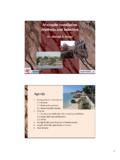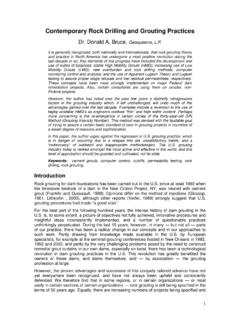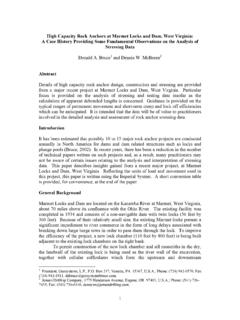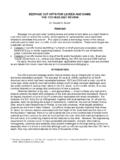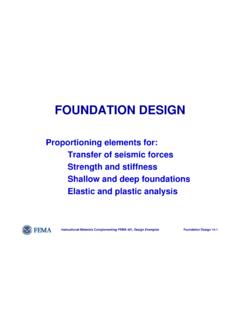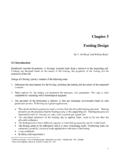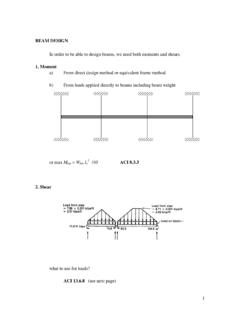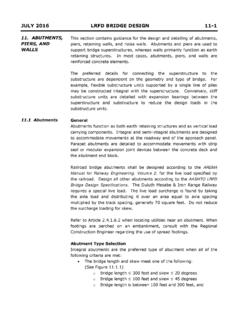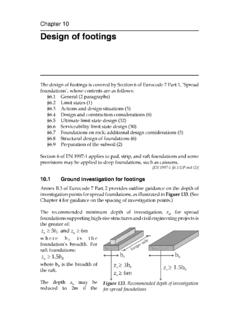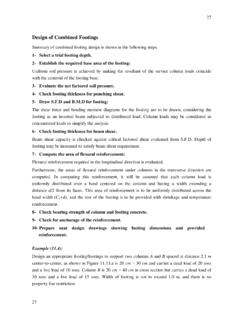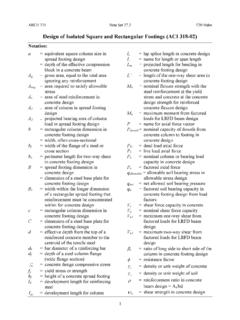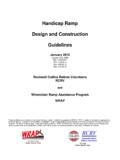Transcription of Connection Capacity between Micropiles and …
1 Connection Capacity between Micropiles and concrete footings : Interpretation of Test Results and design Recommendations Jes s G mez, 1, Allen W. Cadden, , Robert P. Traylor3, Donald A. Bruce, Abstract Micropiles are used extensively for underpinning or retrofit of existing foundations. In many cases, Micropiles are installed through the existing foundation, relying on the bond between the micropile grout and the existing concrete to provide the required Connection Capacity . Because Micropiles are small-diameter elements often designed to carry large axial loads, significant shear stresses may develop between the micropile grout and the existing footing.
2 It is therefore important to establish reasonable criteria to determine the allowable bond strength for design of such connections. It is the experience of the authors that practical design of connections between Micropiles and existing foundations is commonly done based on the individual experience of the designer, or on tests performed by the contractor to model a specific Connection type to be used in a particular project. There is little published data on the bond strength at grout- concrete interfaces that is available to engineers and contractors.
3 For this investigation, a number of load tests were performed on model micropile-footing connections. These tests are described in a companion paper (Wilder et al. 2005). This paper presents an interpretation of the results of these load tests and recommendations for the design of connections of Micropiles to existing footings . The paper also presents results of previous published and unpublished tests on micropile-footing connections and compares them to the results of the tests from this investigation. Finally, additional research needs are identified and discussed.
4 BACKGROUND There are two main sources of information regarding bond strength at steel- concrete interfaces. One is the body of published work on the bond between reinforcing bars and concrete . The other consists of tests performed by micropile specialty contractors 1 Senior Associate, Schnabel Engineering, 510 East Gay Street, West Chester, PA 19380; 2 Director of Geotechnical Engineering, Schnabel Engineering, 510 East Gay Street, West Chester, PA 19380; 3 Traylor Group, LLC, 3525 Ellicott Mils Dr., Unit C Ellicott City, MD 21043; 4 Geosystems, , Box 237, Venetia, PA 15367; for specific applications.
5 The following paragraphs summarize some of the previous work that is relevant to this investigation. Bond Strength of Reinforcing Bars Embedded in concrete The mechanics of development of the bond between reinforcing bars and concrete has been the subject of research for many years and appears to be fairly well known. A complete discussion on the key elements of bond strength along reinforcing bars can be found in American concrete Institute publications ACI 408R-03 (ACI 2003), ACI (ACI 1999), ACI (ACI 1991), and ACI 318R-89 (ACI 1992). Detailed explanations and numerical modeling techniques for development of the bond between reinforcing bars and concrete are frequent in reinforced concrete research literature.
6 Based on the available knowledge, the following conclusions can be made that are relevant to micropile-footing connections: The determination of the development length of reinforcing bars in ACI 318-89, is based on the following expression for bond strength: psidfbcb800' = (1) where: b = maximum bond stress between reinforcing steel and concrete f c = compressive strength of concrete db = reinforcing bar diameter According to ACI , values of maximum bond strength reported in the literature for reinforcing bars in concrete vary from 1,500 to 3,000 psi. These bond values were measured locally over short distances and are not representative of the average maximum bond value along the entire embedded bar length.
7 Average maximum bond values along reinforcing bars in concrete may range between 560 and 800 psi (see Equation 1). The transfer of stresses between the bar and the concrete occurs through steel- concrete adhesion, bearing of the bar ribs, and frictional resistance between concrete and steel. Two types of failures are common for reinforcing bars embedded in concrete . Pullout failure occurs when the bar is sufficiently confined and failure takes place by shearing of the concrete between the top of the bar ribs. Splitting failure of the concrete surrounding the bar may occur if confinement of the bar is insufficient.
8 In this case, tensile radial stresses develop and splitting propagates to the edges of the concrete element resulting in loss of bond. After splitting failure, the bar may retain significant residual Capacity due to frictional resistance within a concrete mass with transverse reinforcement, even after a large slippage of the bar. Also, an increase in transverse reinforcement will generate an increase in the Capacity of the bar unless pullout failure takes place. The bond resistance of reinforcing bars is governed by the properties of the concrete , confinement and volume of the concrete around the bar, and the geometrical and surface characteristics of the bar.
9 Previous Tests on Model Micropile Inserts Several micropile contractors have performed tests to obtain information for design of micropile-to-footing connections. The conditions under which the tests were performed are variable and correspond to the techniques implemented by each contractor at a particular project. A number of model tests were performed by Sehn (1998) to study the Capacity of bar micropile inserts in concrete footings . Two of these tests are directly relevant for comparison with the results from this investigation. A diameter bar was grouted into a predrilled hole in a concrete block.
10 The hole was 8 inches in diameter and was 25 inches long. The walls of the hole were grooved. Neat cement grout was used to backfill the annular space between the bar and the concrete . The first two inches of the bar were encased within a diameter casing. The tests were performed in compression. The maximum bond stress calculated at the walls of the hole ranged between 477 an 509 psi. It is not known whether failure of the insert occurred at the bar-grout interface or by splitting of the block. The tests performed by Sehn (1998) differ from the tests performed during this investigation in that the hole was grooved, and that the bar was capped with a piece of casing.


